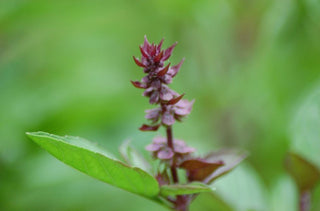A cousin of the popular sweet basil, Thai basil has a somewhat stronger flavor with a hint of licorice and is popular in the cuisines of Southeast Asia. Freshly picked leaves can be added to salads, soups and sandwiches or dried for winter use. The plant is somewhat smaller than most sweet basil varieties, with smaller leaves. The stems and flowers are purple, making the plants right at home in ornamental gardens. The flowers make beautiful garnishes and look lovely in bouquets.

Like other basils, Thai basil is a heat-loving plant and is especially susceptible to frost damage. Seeds and plants should not be put into the ground until the soil is warm (65 to 70 degrees F) and the weather has settled. Even a 50-degree night will slow the plant's growth for some time afterwards.
To get a jump on the season, start basil seeds indoors, three to four weeks before planting time. Basil has a lower germination rate than many seeds, so plant four to six seeds per pot. Once the seedlings have their first set of true leaves, thin to one or two plants per pot. Protect basil plants from wind and sun for the first several days.
Thai basil prefers soil that is lightly moist, slightly acidic, well-drained and rich in organic matter, such as compost. It thrives in full sun but will tolerate part shade.
To get the highest yield of tender and flavorful leaves, pinch the tip of each branch, starting in early summer when the plants are 6" tall, to encourage bushiness. However, if you want to enjoy the beautiful flowers, allow some stems to grow, so they can form buds and blooms.
Related article: Make Your Own Pesto





